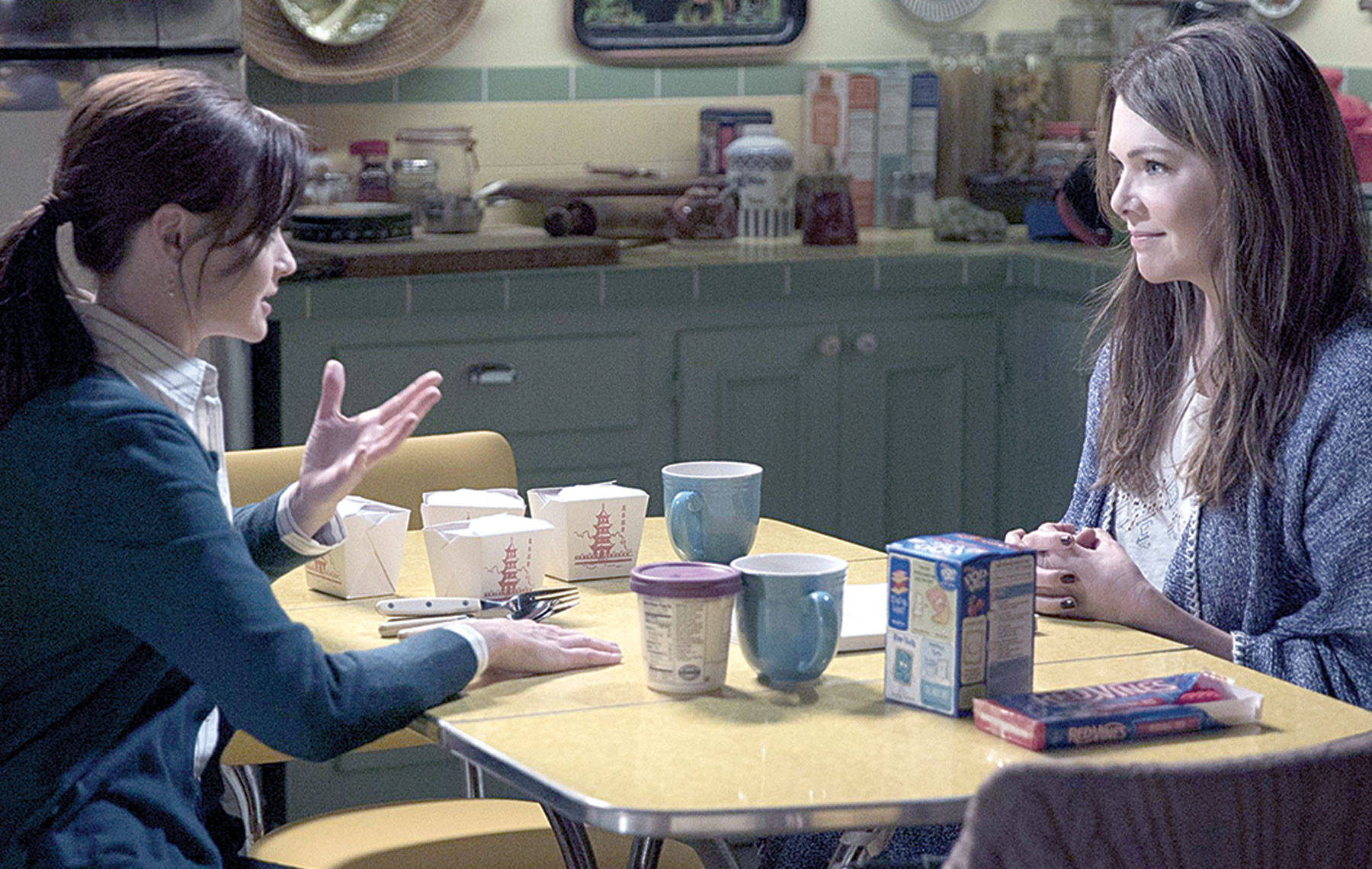 A Still from “Gilmore Girls: A Year in the Life “
A Still from “Gilmore Girls: A Year in the Life “ “You know what I just realized? ‘Oy’ is the funniest word in the entire world.”
Thus spake Lorelai Gilmore, the older of the two eponymous “Gilmore Girls,” moments before she realized that “poodle,” is also a funny word.
“In fact, if you put ‘oy’ and ‘poodle’ together in the same sentence, you’d have a great new catch phrase. You know, like, ‘Oy with the poodles, already.’ ”
The world of “Gilmore Girls” isn’t especially concerned with Jewishness. At least, not beyond a few “bits” like these. But these bits stick out in the world of the Gilmores. The word “oy” is discordant in Stars Hollow, the Connecticut suburb in which the show is set. Perhaps this is because “Gilmore Girls” is the least Jewish TV show I have ever seen.
It is most certainly the least Jewish TV show I have ever loved.
The shows I love are shows that I have loved for 20 years or more and watched countless times. Top in my rotation are “Seinfeld,” “Sex and the City,” “Frasier” and, yes, “Gilmore Girls.”
These shows are not all about Jews. But the world of American television, even when not dealing explicitly with Jews, is touched by Jewish culture, Jewish humor and often created by Jewish writers and producers. In this Jewish media landscape, the un-Jewishness of “Gilmore Girls” is stark.
To understand why, we need to look at what makes other shows feel Jewish, or at least what makes them feel Jew-ish.
The Jewishness of the “Seinfeld” universe is obvious. The characters are Jews and references to matzo ball soup abound. But “Seinfeld’s” Jewishness is deeper than this.
When Jerry asks George if he’s in love with his girlfriend, George shrugs. Jerry asks him if he feels anything for her.
“Feel? What’s that?”
“All right, let me ask you this,” Jerry says. “When she comes over, you’re cleaning up a lot?”
George nods.
“You’re just straightening up or you’re cleaning?”
“Cleaning.”
“You do the tub?”
George says yes.
“OK, I think you’re in love!” Jerry exclaims. “Tub is love.”
Anyone who has ever read a page of Gemara will recognize the talmudic fastidiousness, the rabbinic propensity to take the spiritual and make it quantifiable and to take the quantifiable and make it spiritual.
But a show doesn’t need to be about Jews to have this kind of Jewish sensibility. Devorah Baum, in her book “The Jewish Joke,” identifies two sources of what we call “Jewish humor.”
The first is that Jews have been “the greatest Schlemiels” of history. The second has to do with being both an “outsider” and “at odds with oneself.”
How do these qualities translate into humor? They do so in the form of characters who are their own worst enemies (like George Costanza, like Carrie Bradshaw, like Frasier Crane), but certainly not in the form of characters whose quirky je ne sais quoi will always win the day (like those perky, coffee-loving “Gilmore Girls”).
It should be noted that “Gilmore Girls” originally aired on the WB. The now-defunct WB was also home to “Seventh Heaven,” “Buffy the Vampire Slayer,” “Dawson’s Creek,” “Charmed,” “One Tree Hill,” etc.
This was a network focused on schmaltzy, 45-minute comedic dramas, supernatural soaps and teen shows. Not sitcoms, which tend more toward the cynical and the sarcastic, nor HBO-style prestige shows, which prefer the gritty and the realistic to the harmonious and the comforting.
The world of “Gilmore Girls” is fittingly saccharine. Being a drama, it is full of family spats, tearful confrontations and crises large and small. But because this is the WB, the viewer can take comfort in the knowledge that a happy ending is assured in the series finale.
In the world of “Gilmore Girls,” fate can be trusted. Stumbling blocks are put in characters’ paths to teach them a lesson and get them where they need to be. The central crisis of the show is the fact that Lorelai got pregnant as a teenager and ran away from home to raise her infant on her own.
Regardless of how such stories turn out in the real world, Lorelai and baby Rory somehow managed to find their way in a quaint Connecticut suburb. Sixteen years later, Lorelai and her daughter live comfortably in a two-story home and are beloved by all the quirky townsfolk. Throughout the seven seasons of the show, viewers see many more unwanted and unplanned pregnancies played out as plot devices. But it all works out. As one Vox writer wrote, in Stars Hollow, “pregnancy is destiny.” And destiny is kind.
Shows with a Jewish sensibility tend to display more skepticism toward the kindness of destiny. Perhaps this has something to do with being history’s “greatest Schlemiels.”
But it’s precisely this kind of darkness, which has proven to be such fertile ground for comedy, that “Gilmore Girls” creator Amy Sherman-Palladino seems intent on avoiding, despite having now created what is arguably the most Jewish show of the decade, “The Marvelous Mrs. Maisel.”
“Mrs. Maisel” is different from “Gilmore Girls” in a few ways.
It’s an Amazon show. Sherman-Palladino is free to use F-bombs and talk about sex.
It is also a Jewish show. We’ve moved from the small town to the city, where we’re surrounded by Yiddishkayt, Jewish families, Lenny Bruce, brisket and kosher dills.
But is this world any more Jewish than that of “Gilmore Girls”?
Like Stars Hollow, the world of “Maisel” is cute and safe. Destiny is still a thing to be trusted.
No matter where she goes, Midge Maisel is able to charm her way out of any problem. She’s a winner, and the joy of the show comes from watching her win.
Since the days of “Oy with the poodles, already,” Sherman-Palladino has added quite a few more Yiddishisms to her word bank. The show seems intent on reminding viewers of its Jewishness at every turn. Perhaps this is because, at its heart, it lacks a Jewish bite and a Jewish eye.
The characters, like those on “Gilmore Girls,” are quirky more than they are neurotic. The difference is that quirks are endearing. Neuroses, like those George Costanza has, are heartbreaking.
In “Gilmore Girls,” one of Lorelai’s most beloved quirks was her unpretentious take on interior décor. She loved campy tchotchkes, much to the chagrin of her conservative mother. One of her favorites was a dancing rabbi that sings “Havah Nagilah” when you press the button on its back.
The doll, dressed in Chasidic garb, may not actually be a rabbi. It may be just a Chasidic Jew, but it’s referred to as a rabbi, and really, who cares?
It’s camp. It’s kitsch. It’s quirky. It’s decorative. And its main function is to show us how special and cute Lorelai is.
I’m not sure that the vastness of Jewish culture on “Mrs. Maisel” serves a function much broader than this.
Matthew Schultz is a writer living and working in Tel Aviv.























 More news and opinions than at a Shabbat dinner, right in your inbox.
More news and opinions than at a Shabbat dinner, right in your inbox.